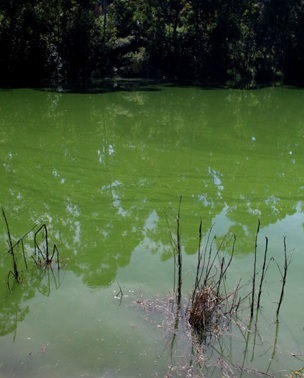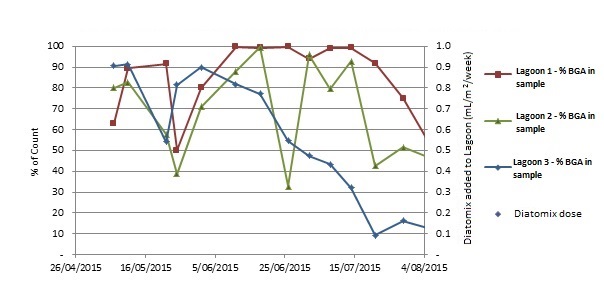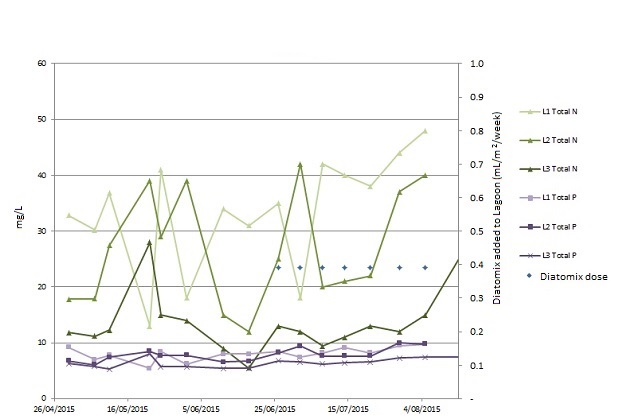This blog post is somewhat more technical than some of the other posts I have done to date. The reason for this is that I am presenting actual data! Yes! The numbers are in and I have graphs, relationships and hypotheses to offer. So if you are interested in the more analytical side of things then I hope you enjoy this post. As we are moving towards summer here in Australia things are warming up so the cyanobacteria are getting more active and the use of Diatomix in these tests is going to get properly tested to see how good it is. I hope you enjoy the report and as always, feel free to contact me if you want to know more.

Diatomix is a nano-silica nutrient mixture that has all the micronutrients required for growth of diatom microalgae adsorbed into the amorphous nano-silica structure. As only diatoms have a requirement to take up silica, they are the only algae that benefit from the micro-nutrient boost. This means that the diatoms successfully out-compete the other algae for nutrients, and reduce blue-green algae growth in a natural way. The process is non-toxic and offers an added benefit in that bacterial activity is enhanced due to the increased dissolved oxygen content from the diatom bloom. This increase in dissolved oxygen and bacterial activity will assist in bringing down the biochemical oxygen demand (BOD) in the wastewater.
The information below provides an overview of three separate trials that have each been running for more than 12 weeks. Each of these trials is on-going with AlgaEnviro. The dosing calculations were made from the influent values provided by the industry partner in charge of these sites. Each trial has had a slightly different approach in regards to dosing, but all dosing calculations are related to the influent nitrogen (N) concentration and the existing N concentration in the lagoon or dam.With the different dosing approaches taking place, there have been a range of responses that have provided valuable insights into the use of Diatomix and the most notable trends are presented here.
Trial 1
Trial 1 is at a Lagoon Sewage Treatment Plant (STP) that has an Imhoff tank for solids separation, followed by a nitrification-denitrification step, settling and effluent release into the lagoon.
Two weeks of background sampling were completed prior to the trial starting. During the first dosing regimen the amount of Diatomix used was sufficient to manage the background level of N in the lagoon, but did not address the influent N coming from the STP itself. The dosing of Diatomix started showing early effects where the silicate levels dropped by 3 mg/L in two weeks (Figure 1). This drop indicates that the diatom activity was induced by the addition of Diatomix as the only clear reason why silicate levels would drop is due to the silica (Si) uptake by diatoms. There was a corresponding reduction in the N and phosphorus (P) levels during this period which are also associated with nutrient uptake by the diatoms.




There were two reasonably large rain events during the first dosing regimen and this increased flow into the STP Lagoon, and there were corresponding spikes in the N, P and Si measurements. This is most likely due to the stirring up of settled settlements during the rainfall events. Biochemical Oxygen Demand (5 days) (BOD5) and Chemical Oxygen Demand (COD) also spiked during the rain events.
After three weeks of dosing the lagoon with Diatomix, dosing was halted so as to assess how the lagoon would respond without dosing of Diatomix. Noting that there were no further rain events during the trial, there was an increase in the degree of fluctuation in the N, P, BOD5 and COD measurements. The fluctuations were noticeably greater than during the initial Diatomix dosing period when the spikes caused by rain events are ignored.
The dosing of Diatomix commenced again six weeks later, with the size of the dose being sufficient to address both the background N concentration in the lagoon as well as the mass of N entering the lagoon from the STP. From the start of this second period, the Si again began to trend downward, showing a consistent uptake of Si through diatom activity. The degree of stability in the values for N, P, BOD5 and COD also returned to the similar behaviour seen during the first dosing regimen. Due to the lack of rainfall during the second period of dosing, the stability within the results is even more pronounced.
Prior to the start of the first Diatomix dosing, the percentage of the Total Cell count that was made up of Blue Green Algae (BGA), was greater than 99% (Figure 2). With the additions of Diatomix, this percentage began to trend downward and reached a low of 96% during the first dosing period. While this was only a change of 3%, the dose used was below the standard and recommended dose rate, the implication being there was an effect although not profound.
A clearer change appeared with the second dosing period in regard to the proportion of BGA in the Total Cell count, with a reduction to 83.9% as BGA, also called cyanobacteria. As well as this proportional change, the Total Cell count has greatly reduced (Figure 3). Note should be made that the BGA data (in blue in Figure 3) is obscured by the Total Cell Count data (in green) as the two values are so similar until after the increased dosing, when the difference is still not seen in this figure. In many situations the scenario where Total Cell Count is greatly reduced may be a concern as it is recognised that the growth of algae is required so as to reduce the concentration of nutrients in the water. The Total Cell count has reduced as low as 2,400 cells/mL from a previous high of 9,328,000 cells/mL, and yet the nutrient levels have remained stable and low. The explanation for this is associated with the decrease in the Si level as seen in Figure 1. The hypothesis is that the nutrients are being taken up by the increased activity of diatom algae in the benthic zone, and so despite a decrease in the Total Cell Count observed from the sampling, the management of nutrients through diatom algae continues in the benthic zone.
The additional benefits of having the pelagic or suspended algal cell count reduce so dramatically is that there is a greater penetration of ultra-violet light from the sun into the lagoon water which improves effluent disinfection. The difference in the state of the pond can be seen in (Figure 4), the image on the left was prior to the trial beginning and the right hand image is during the second dosing period. The most notable aspects are the loss of the ‘blue-green’ colour in the water and how the algal density has reduced as the lagoon bottom can be seen to a greater depth. The coloration in the right hand image shows that a different group of algae, many known as ‘brown algae’ are now present.
Furthermore the diatom algae that are growing in the benthic zone get more light when there is a lower suspended algae population. These diatoms are also a good food source for the zooplankton and invertebrates in the lagoon. As such the nutrients are removed from the water and enter the food chain where they are more stably retained in the long term.
Trial 2



The second trial site consists of an Imhoff tank and a series of three lagoons. The Diatomix was dosed into the third lagoon after six weeks of monitoring. The dosing rate was 0.4 mg/L in this trial, as compared to the 0.1 and then 0.2 mg/L dosing of Trial 1.
There has been a marked reduction in Total Blue Green Algae in Lagoon 3, without a similar trend of consistent lower BGA algae, as a percentage of the Total Cell count, being seen in Lagoons 1 and 2 (Figure 5).
The proportion of the Total Cell Count that is BGA has been an average of 98% in Lagoon 1 and 87% in Lagoon 2. In Lagoon 3 this proportion has been 84%, until the dosing of Diatomix in Lagoon 3 began and since then the average value has reduced to 25%.
The Total cell count of Lagoon 3 has been slightly different than in Trial 1, where the BGA count is reducing but the Total Cell Count has initially reduced and then increased again (Figure 6). This is likely to be because the reduction in BGAs has created a condition where other non-diatom algae can increase due to more light. This is not seen as a negative effect as the main intent in this trial is to reduce BGA activity.
The nutrient levels in Lagoon 3 have not shown any trend for reduction or change during the trial (Figure 7) but the stability of the readings is far greater than the other lagoons.
Trial 3


The third trial to test the use of Diatomix is different from the first two. In this trial Diatomix was dosed into a wastewater effluent storage dam, not in a treatment lagoon. The dam has a depth of 10 m, so only a small proportion of the total volume is in the Photosynthetically Active Radiation (PAR) Zone which is usually the top 0.5 m of any waterbody. In this trial the main intent was to reduce the pH of the dam, as over the last four years it has slowly increased year on year and was averaging 8.9 at the beginning of the trial. The levels of inorganic N, available to algae for growth were exceptionally low relative to the level of inorganic P (Figure 8). This extremely low N value made the conditions very suitable for the proliferation of BGA species as they are able to fix their own N, whereas algae require a source of N present in the water. To overcome this problem and to assist with the growth of diatoms during the dosing of Diatomix, urea fertiliser was added at the same time as the dosing of the Diatomix for the first four weeks of the trial.
The additions of the urea (100 kg per week) had a marked effect, creating an algal bloom in the dam, with both an increase of BGA and diatom algae particularly during the period of 19th of May (Figure 9). What is most important in this trial is the changes that occurred after this initial bloom induced by the addition of urea. The pH reduced to 8.5, which had not occurred in more than 12 months, and after the BGA bloom died off there was a persistent increase in the levels of inorganic N, without a further addition of urea after the 23rd of June. This persistent increase in inorganic N is attributed to an on-going bloom of diatom algae.
Whilst the diatom population slowly decreased as seen in Figure 9, it should be noted that these cell counts only represent pelagic or suspended algae. The benthic algae that live on surfaces such as the grasses, and the dam floor within the PAR zone are very likely to be growing actively. The hypothesis is that the diatom algae activity in the benthic zone is increasing the dissolved oxygen (DO) levels around this area and this additional DO will increase the bacterial activity, more quickly degrading organic matter on the floor of the dam. The organic matter degradation in turn releases more nutrients, which supports further diatom growth. Due to the expense of additional monitoring this hypothesis cannot be tested, but review by members of the industry partner in this trial has brought a consensus that this is the most likely explanation for the ongoing availability of inorganic N and the lower, stable pH.
The percentage of the Total Cell Count that is represented by BGA is still very high. Prior to the start of this trial, the BGA consistently made up 99.6% or more of the Total Cell count. Since the trial began the dosing of Diatomix this percentage has decreased as far as 97.8%, and seven of the 8 weeks had a percentage below 99.6%. While recognising that this is not a large change, the conditions for other algal growth is poor and so any decrease in this percentage is a good indication of a slow and consistent change. Furthermore, as suggested above, most diatom growth is expected to be benthic, and the inorganic N levels are suggested to be due to the increased benthic diatom growth.
One further piece of anecdotal evidence regarding this hypothesis for increased diatom growth and improved water conditions is that the site operator at this dam noted that the number of water insects observed from June 25th is “immense” and that he has never seen so much insect activity in the past. This observation further supports the suggestion that benthic diatom activity is strong, as the benthic diatoms are a good food source for zoo plankton and in turn for the invertebrate population.
Summary

The three trials presented here are each slightly different in regard to the conditions of the STP or the water being treated. Trials 1 and 2 have both shown a strong change in the percentage of the BGA that make up the Total Cell count. A similar pattern may slowly be emerging in Trial 3 which has a lower N concentration.
The Total Cell Counts in all trials have been seen to reduce markedly from the starting values. Trial 2 has shown some recovery of non BGA algae, although this stage may be transitory as the lagoon continues to settle toward having a higher DO and lower BGA population.
Because of the increased activity of diatoms, especially benthic diatoms, induced by the addition of Diatomix there have been several positive changes to the water quality. In Trial 3, a reduction in the pH and a qualitative assessment that the invertebrate populations in the water have increased suggest that the water is progressively returning to a more stable environment in which algae other than BGAs may proliferate and the nutrients will shift from being retained in algal cycles and may now move up the food chain through the invertebrates and into higher animals such as fish, eels and birds.
Longer trials are needed to assess the long term use of Diatomix in managing nutrients and controlling Blue Green Algae growth, but these three trials are strongly indicative that the use of Diatomix is a simple and effective pathway to achieve this outcome.